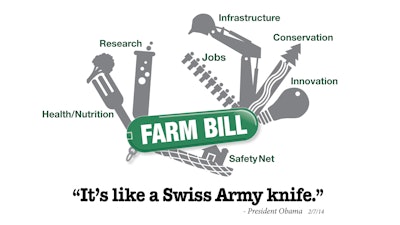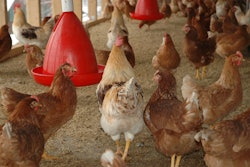
Current farm legislation runs through the 2018 crop year and congressional consideration of a new farm bill will begin with congressional hearings in 2017. The congressional farm bill process will likely be a challenging one with many factors affecting the timing and final outcome.
Farm economy
Due to the downturn in the farm economy, some farm groups and some members of Congress, in-cluding Senior Democrat Collin Peterson on the House Agriculture Committee, are calling for the Congress to take up and approve a new farm bill a year early in 2017.
Prices for major agricultural commodities are down 40% to 50% from the record highs of several years ago. Net farm income,has fallen from more than $123 billion in 2013 to an expected $55 billion for 2016. U.S. Department of Agriculture analysts and most market observers believe lower prices and incomes will generally continue for the next several years.
USDA analysts project federal outlays for farm commodity programs — not including Federal Crop Insurance — to rise from about $5 billion in fiscal year 2015 to more than $13 billion in fiscal years 2016 and 2017. Especially with much higher spending on the farm commodity programs compared to earlier estimates, there will likely be political pressure on the Congress to limit growth or even to roll back farm commodity spending toward lower levels.
Debt limit
The waiver of the federal debt limit agreed to by Congress in the 2015 Budget Act expires March 17, 2017. By then, the national debt will total around $20 trillion, about doubling in the last eight years. Estimates for the deficit in future years exceed $500 billion per year. So the national debt is expected to grow by more than a half trillion dollars every year on into the future—assuming no economic recession which would make the deficit/debt situation much worse. Presidential candidates Donald Trump and Hillary Clinton have not spoken much about this growing deficit and debt situation. Many voters don’t consider federal deficit and debt issues major concerns right now, but in the spring of 2017 the Congress must either continue to waive the debt limit or reset it to a higher level for the federal government to continue operating. This could result in a new budget agreement with new taxes and spending cuts including a budget reconciliationprocess to help achieve the spending reductions.
If a budget reconciliation process would take place in 2017 or 2018, it would very likely include cuts (changes) in farm commodity programs and other agricultural programs before the expiration of the 2014 farm bill.
So while some growers are asking for an early farm bill to increase grower income support, at the same time there will very likely be political pressure for Congress to act to change farm programs to limit, or even roll back federal farm spending.
Regardless of whether there is a budget reconciliation process, the growing debt/deficit situation will surely have an impact on congressional legislation, including farm legislation during the 2017/2018 session of the Congress.
Supplemental Nutrition Assistance Program
There is additional uncertainty because of the view of some stakeholders, including some members of Congress, that since the Supplemental Nutrition Assistance Program (formerly the Food Stamp Program) and other nutrition programs account for about 80% of farm bill spending they should be split off and considered separately from the farm commodity, conservation and other agricultural programs normally included in a farm bill. Many disagree with this view. The linking of nutrition programs with the farm commodity, conservation and other programs included in a farm bill is necessary to attract enough votes of members of Congress from suburban and urban areas to gain approval of the farm commodity and other programs.
Crop insurance
The Federal Crop Insurance Program carried out through private insurance companies and agents has become a much more important part of the income safety net for farmers. Federal program costs including premium subsidies, the federal share of administrative costs, the federal share of indemnity losses, etc. exceeded $8 billion in 2015. Reduced commodity prices and farm incomes, even without a major weather disaster, could result in growing outlays under the Federal Crop Insurance Program over the next few years.
Federal Crop Insurance has already become a major target for budget cuts in Congress. The budget act approved by Congress in the fall of 2015 included reductions of $3 billion in federal reimbursement of costs to the private companies. The cuts were quickly reversed by the Congress when all of U.S. agriculture protested, but the Federal Crop Insurance program will continue to be a major target for budget reductions during 2017/2018.
Funding competition
There is always some competition between the commodity groups for spending resources in farm legislation. That competition could be greater than normal during consideration of the new farm bill. Income support for dairy and cotton producers is significantly less under new programs adopted in the 2014 Farm Bill. Federal outlays for grains and oilseeds under new programs initiated in the 2014 Farm Bill will be much greater than expected, driving total commodity program costs to levels more than twice those projected when the 2014 Farm Bill was approved by the Congress.
Congressional approval of a new farm bill to replace the existing farm bill will take place during challenging political and economic times that will impact the timing and outcome of a new bill. The expected savings from eliminating direct payments to growers will not be achieved from the 2014 Farm Bill. Instead, outlays for the 2014 bill are expected to be more than double earlier estimates due to the downturn in the agricultural economy. The downturn across U.S. agriculture is significant with net farm income over the next few years expected to be more than 40% below the record levels of several years ago. Within the farm community, there is disparity in the level of spending/income support provided by the 2014 farm legislation. Dairy and cotton producers in particular have been disappointed by the 2014 farm bill programs. There will be political pressure from agricultural interests to improve and expand the income safety for agriculture, but there will also be political pressure to limit or even roll back federal spending on farm commodity programs and the Federal Crop Insurance Program. ❚


















